An Analysis of Leadership and Management in Aldi Supermarket Chain
VerifiedAdded on 2020/10/22
|9
|2575
|258
Report
AI Summary
This report provides a comprehensive analysis of the leadership and management practices at Aldi, a global supermarket chain. It begins with an introduction to the company, its history, vision, and leadership styles. The report delves into the autocratic, consultative, and democratic leadership styles employed by Aldi's managers, along with an examination of the strategies the company has implemented, including the application of Theory X and Theory Y for employee motivation. The analysis further explores the implemented strategies by the company. The report then offers recommendations for improving leadership styles and management practices within Aldi, focusing on essential characteristics such as personality, knowledge, communication skills, motivational skills, and decisive skills. The report concludes by summarizing the key findings and insights regarding Aldi's leadership and management approaches.
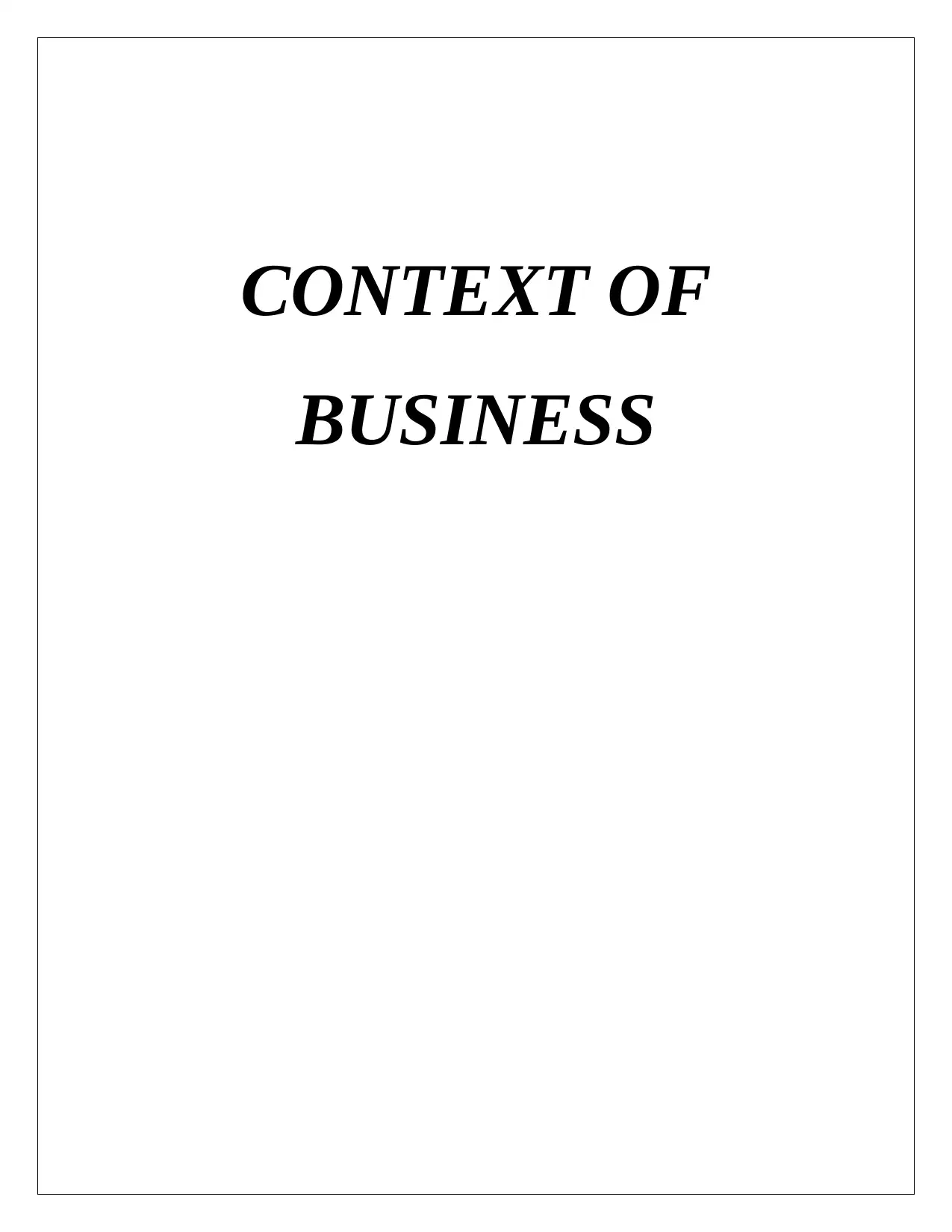
CONTEXT OF
BUSINESS
BUSINESS
Paraphrase This Document
Need a fresh take? Get an instant paraphrase of this document with our AI Paraphraser
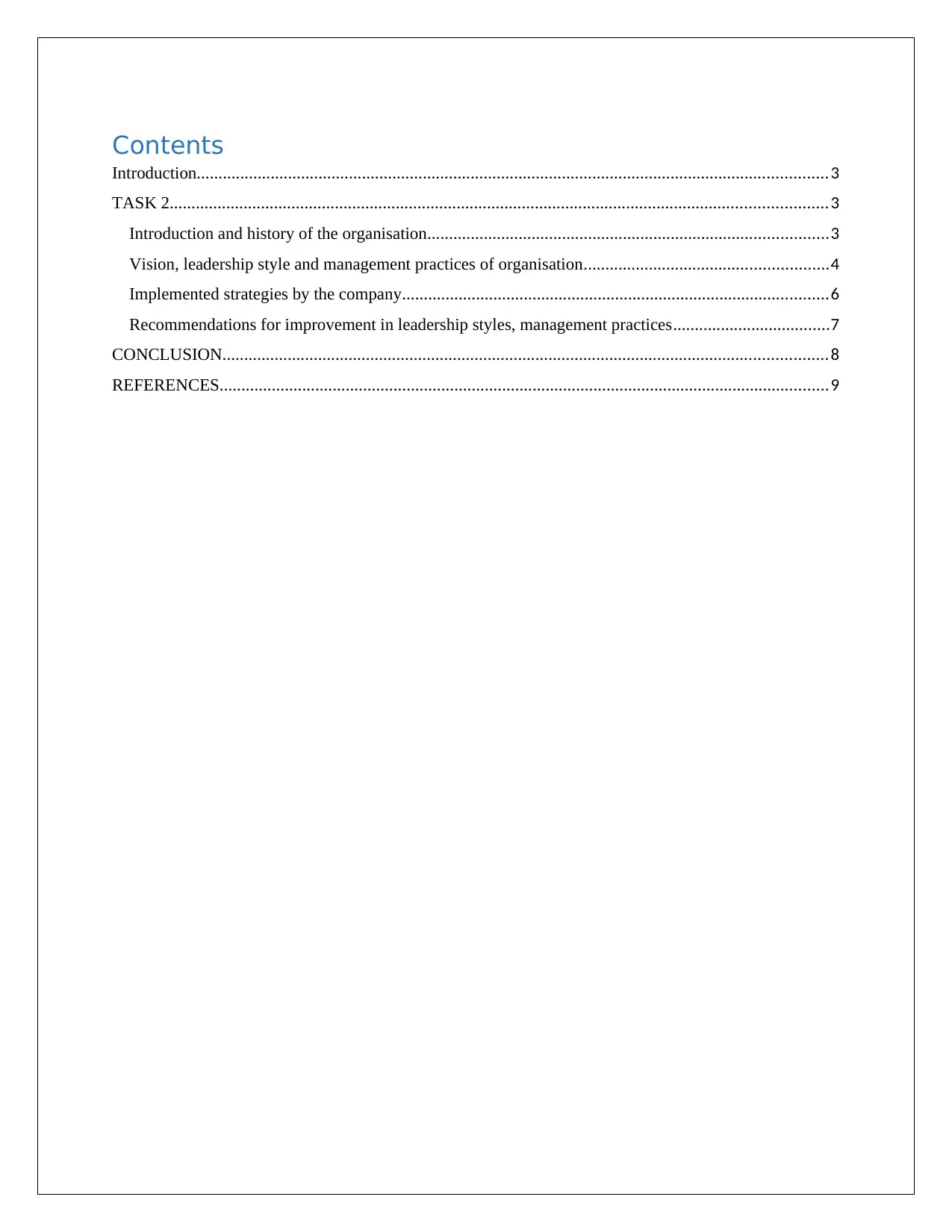
Contents
Introduction.................................................................................................................................................3
TASK 2.......................................................................................................................................................3
Introduction and history of the organisation............................................................................................3
Vision, leadership style and management practices of organisation........................................................4
Implemented strategies by the company..................................................................................................6
Recommendations for improvement in leadership styles, management practices....................................7
CONCLUSION...........................................................................................................................................8
REFERENCES............................................................................................................................................9
Introduction.................................................................................................................................................3
TASK 2.......................................................................................................................................................3
Introduction and history of the organisation............................................................................................3
Vision, leadership style and management practices of organisation........................................................4
Implemented strategies by the company..................................................................................................6
Recommendations for improvement in leadership styles, management practices....................................7
CONCLUSION...........................................................................................................................................8
REFERENCES............................................................................................................................................9
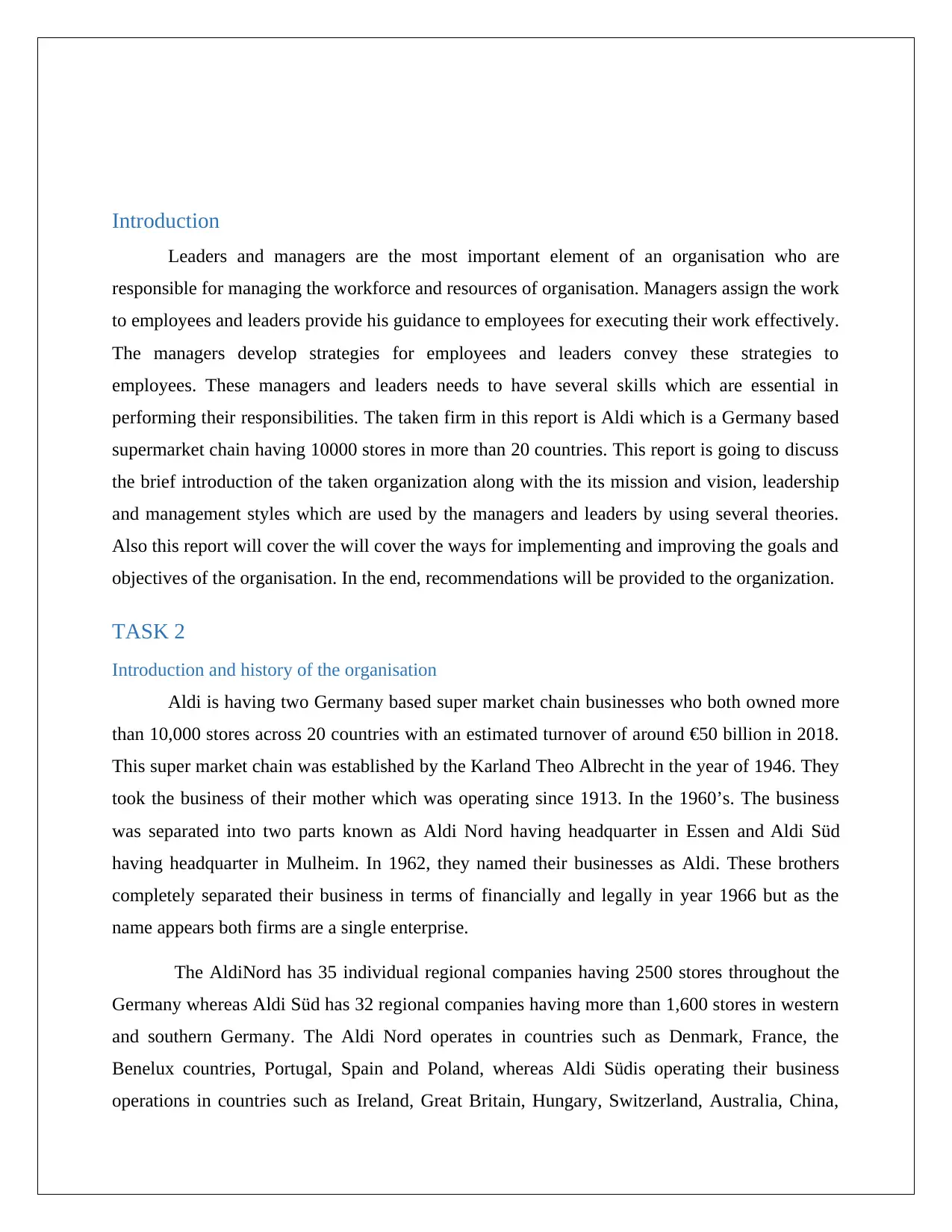
Introduction
Leaders and managers are the most important element of an organisation who are
responsible for managing the workforce and resources of organisation. Managers assign the work
to employees and leaders provide his guidance to employees for executing their work effectively.
The managers develop strategies for employees and leaders convey these strategies to
employees. These managers and leaders needs to have several skills which are essential in
performing their responsibilities. The taken firm in this report is Aldi which is a Germany based
supermarket chain having 10000 stores in more than 20 countries. This report is going to discuss
the brief introduction of the taken organization along with the its mission and vision, leadership
and management styles which are used by the managers and leaders by using several theories.
Also this report will cover the will cover the ways for implementing and improving the goals and
objectives of the organisation. In the end, recommendations will be provided to the organization.
TASK 2
Introduction and history of the organisation
Aldi is having two Germany based super market chain businesses who both owned more
than 10,000 stores across 20 countries with an estimated turnover of around €50 billion in 2018.
This super market chain was established by the Karland Theo Albrecht in the year of 1946. They
took the business of their mother which was operating since 1913. In the 1960’s. The business
was separated into two parts known as Aldi Nord having headquarter in Essen and Aldi Süd
having headquarter in Mulheim. In 1962, they named their businesses as Aldi. These brothers
completely separated their business in terms of financially and legally in year 1966 but as the
name appears both firms are a single enterprise.
The AldiNord has 35 individual regional companies having 2500 stores throughout the
Germany whereas Aldi Süd has 32 regional companies having more than 1,600 stores in western
and southern Germany. The Aldi Nord operates in countries such as Denmark, France, the
Benelux countries, Portugal, Spain and Poland, whereas Aldi Südis operating their business
operations in countries such as Ireland, Great Britain, Hungary, Switzerland, Australia, China,
Leaders and managers are the most important element of an organisation who are
responsible for managing the workforce and resources of organisation. Managers assign the work
to employees and leaders provide his guidance to employees for executing their work effectively.
The managers develop strategies for employees and leaders convey these strategies to
employees. These managers and leaders needs to have several skills which are essential in
performing their responsibilities. The taken firm in this report is Aldi which is a Germany based
supermarket chain having 10000 stores in more than 20 countries. This report is going to discuss
the brief introduction of the taken organization along with the its mission and vision, leadership
and management styles which are used by the managers and leaders by using several theories.
Also this report will cover the will cover the ways for implementing and improving the goals and
objectives of the organisation. In the end, recommendations will be provided to the organization.
TASK 2
Introduction and history of the organisation
Aldi is having two Germany based super market chain businesses who both owned more
than 10,000 stores across 20 countries with an estimated turnover of around €50 billion in 2018.
This super market chain was established by the Karland Theo Albrecht in the year of 1946. They
took the business of their mother which was operating since 1913. In the 1960’s. The business
was separated into two parts known as Aldi Nord having headquarter in Essen and Aldi Süd
having headquarter in Mulheim. In 1962, they named their businesses as Aldi. These brothers
completely separated their business in terms of financially and legally in year 1966 but as the
name appears both firms are a single enterprise.
The AldiNord has 35 individual regional companies having 2500 stores throughout the
Germany whereas Aldi Süd has 32 regional companies having more than 1,600 stores in western
and southern Germany. The Aldi Nord operates in countries such as Denmark, France, the
Benelux countries, Portugal, Spain and Poland, whereas Aldi Südis operating their business
operations in countries such as Ireland, Great Britain, Hungary, Switzerland, Australia, China,
⊘ This is a preview!⊘
Do you want full access?
Subscribe today to unlock all pages.

Trusted by 1+ million students worldwide
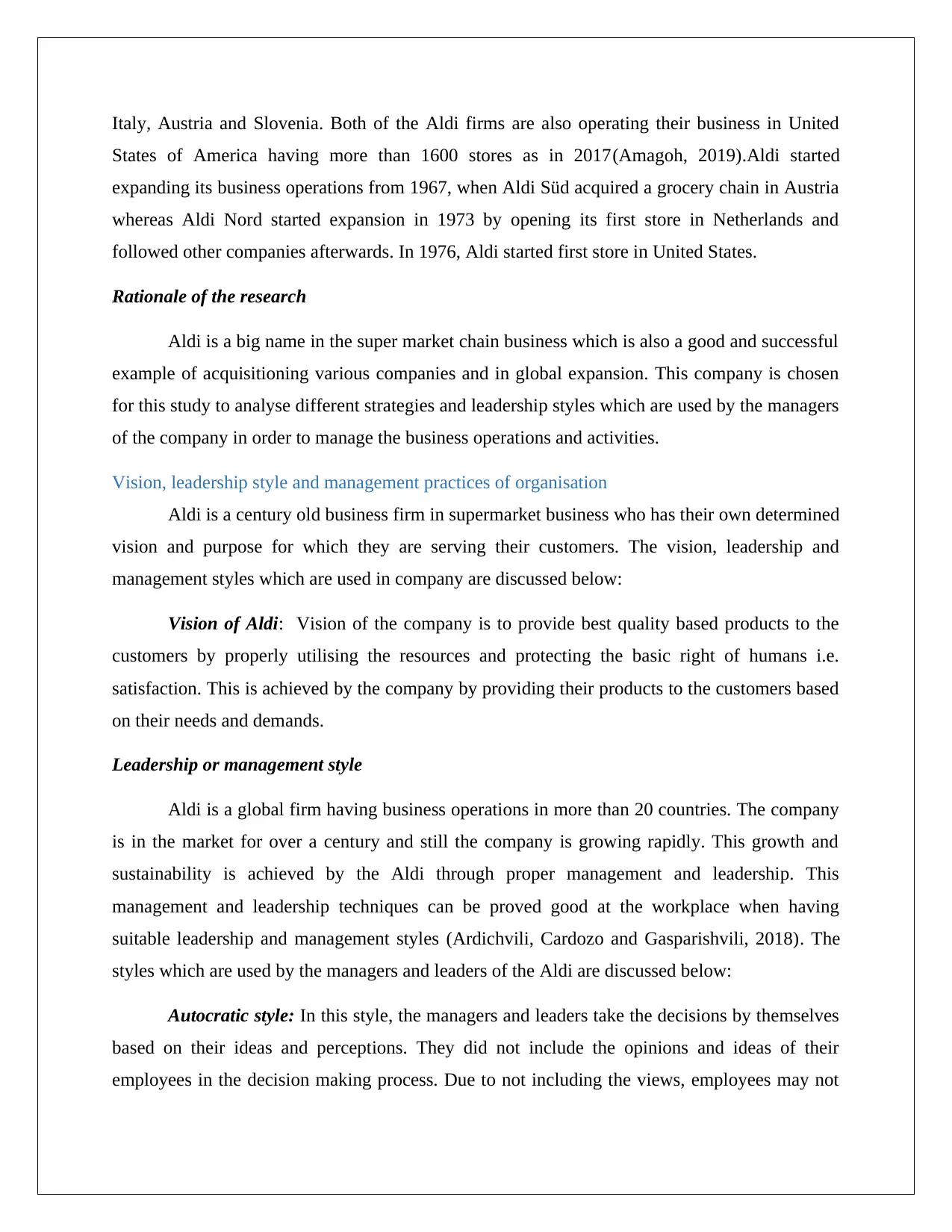
Italy, Austria and Slovenia. Both of the Aldi firms are also operating their business in United
States of America having more than 1600 stores as in 2017(Amagoh, 2019).Aldi started
expanding its business operations from 1967, when Aldi Süd acquired a grocery chain in Austria
whereas Aldi Nord started expansion in 1973 by opening its first store in Netherlands and
followed other companies afterwards. In 1976, Aldi started first store in United States.
Rationale of the research
Aldi is a big name in the super market chain business which is also a good and successful
example of acquisitioning various companies and in global expansion. This company is chosen
for this study to analyse different strategies and leadership styles which are used by the managers
of the company in order to manage the business operations and activities.
Vision, leadership style and management practices of organisation
Aldi is a century old business firm in supermarket business who has their own determined
vision and purpose for which they are serving their customers. The vision, leadership and
management styles which are used in company are discussed below:
Vision of Aldi: Vision of the company is to provide best quality based products to the
customers by properly utilising the resources and protecting the basic right of humans i.e.
satisfaction. This is achieved by the company by providing their products to the customers based
on their needs and demands.
Leadership or management style
Aldi is a global firm having business operations in more than 20 countries. The company
is in the market for over a century and still the company is growing rapidly. This growth and
sustainability is achieved by the Aldi through proper management and leadership. This
management and leadership techniques can be proved good at the workplace when having
suitable leadership and management styles (Ardichvili, Cardozo and Gasparishvili, 2018). The
styles which are used by the managers and leaders of the Aldi are discussed below:
Autocratic style: In this style, the managers and leaders take the decisions by themselves
based on their ideas and perceptions. They did not include the opinions and ideas of their
employees in the decision making process. Due to not including the views, employees may not
States of America having more than 1600 stores as in 2017(Amagoh, 2019).Aldi started
expanding its business operations from 1967, when Aldi Süd acquired a grocery chain in Austria
whereas Aldi Nord started expansion in 1973 by opening its first store in Netherlands and
followed other companies afterwards. In 1976, Aldi started first store in United States.
Rationale of the research
Aldi is a big name in the super market chain business which is also a good and successful
example of acquisitioning various companies and in global expansion. This company is chosen
for this study to analyse different strategies and leadership styles which are used by the managers
of the company in order to manage the business operations and activities.
Vision, leadership style and management practices of organisation
Aldi is a century old business firm in supermarket business who has their own determined
vision and purpose for which they are serving their customers. The vision, leadership and
management styles which are used in company are discussed below:
Vision of Aldi: Vision of the company is to provide best quality based products to the
customers by properly utilising the resources and protecting the basic right of humans i.e.
satisfaction. This is achieved by the company by providing their products to the customers based
on their needs and demands.
Leadership or management style
Aldi is a global firm having business operations in more than 20 countries. The company
is in the market for over a century and still the company is growing rapidly. This growth and
sustainability is achieved by the Aldi through proper management and leadership. This
management and leadership techniques can be proved good at the workplace when having
suitable leadership and management styles (Ardichvili, Cardozo and Gasparishvili, 2018). The
styles which are used by the managers and leaders of the Aldi are discussed below:
Autocratic style: In this style, the managers and leaders take the decisions by themselves
based on their ideas and perceptions. They did not include the opinions and ideas of their
employees in the decision making process. Due to not including the views, employees may not
Paraphrase This Document
Need a fresh take? Get an instant paraphrase of this document with our AI Paraphraser
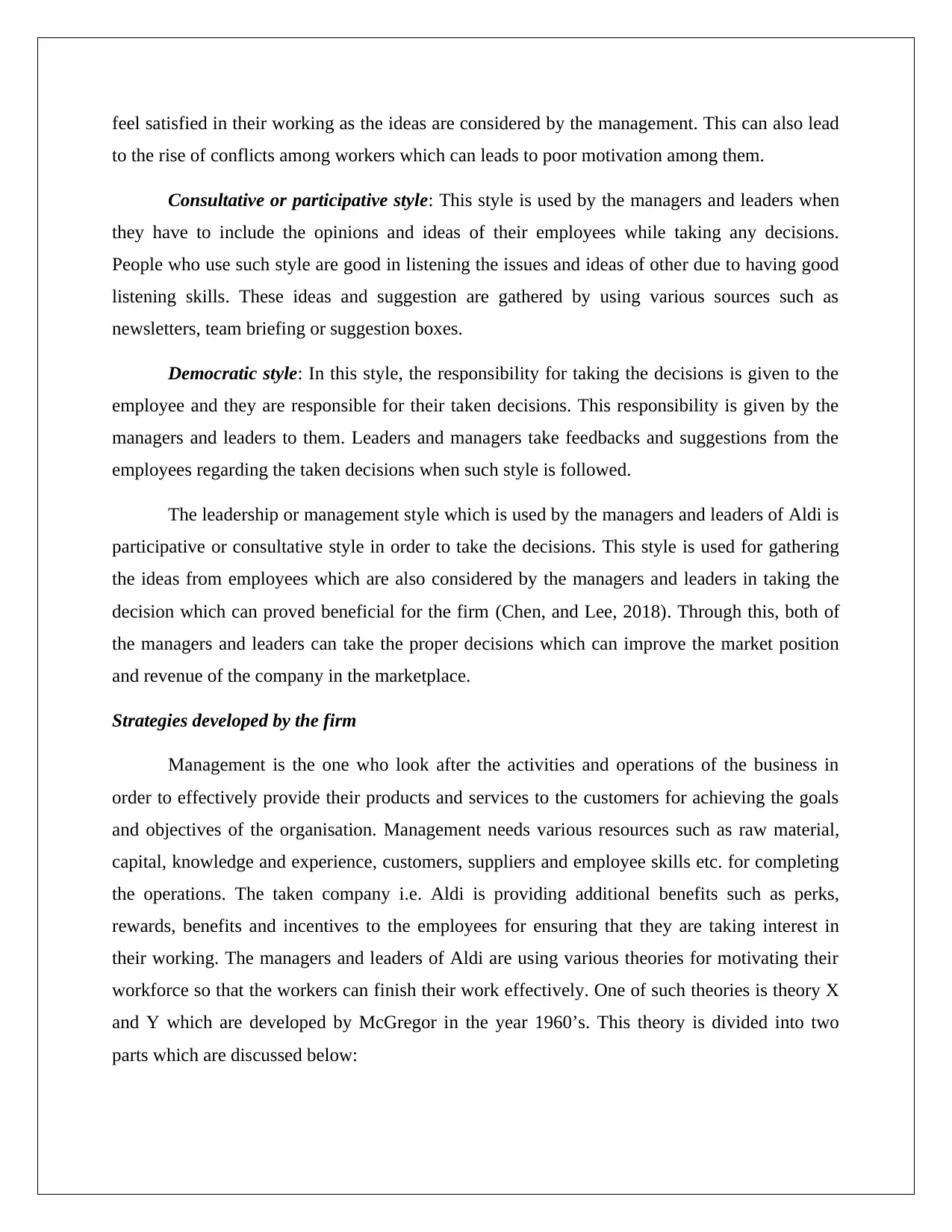
feel satisfied in their working as the ideas are considered by the management. This can also lead
to the rise of conflicts among workers which can leads to poor motivation among them.
Consultative or participative style: This style is used by the managers and leaders when
they have to include the opinions and ideas of their employees while taking any decisions.
People who use such style are good in listening the issues and ideas of other due to having good
listening skills. These ideas and suggestion are gathered by using various sources such as
newsletters, team briefing or suggestion boxes.
Democratic style: In this style, the responsibility for taking the decisions is given to the
employee and they are responsible for their taken decisions. This responsibility is given by the
managers and leaders to them. Leaders and managers take feedbacks and suggestions from the
employees regarding the taken decisions when such style is followed.
The leadership or management style which is used by the managers and leaders of Aldi is
participative or consultative style in order to take the decisions. This style is used for gathering
the ideas from employees which are also considered by the managers and leaders in taking the
decision which can proved beneficial for the firm (Chen, and Lee, 2018). Through this, both of
the managers and leaders can take the proper decisions which can improve the market position
and revenue of the company in the marketplace.
Strategies developed by the firm
Management is the one who look after the activities and operations of the business in
order to effectively provide their products and services to the customers for achieving the goals
and objectives of the organisation. Management needs various resources such as raw material,
capital, knowledge and experience, customers, suppliers and employee skills etc. for completing
the operations. The taken company i.e. Aldi is providing additional benefits such as perks,
rewards, benefits and incentives to the employees for ensuring that they are taking interest in
their working. The managers and leaders of Aldi are using various theories for motivating their
workforce so that the workers can finish their work effectively. One of such theories is theory X
and Y which are developed by McGregor in the year 1960’s. This theory is divided into two
parts which are discussed below:
to the rise of conflicts among workers which can leads to poor motivation among them.
Consultative or participative style: This style is used by the managers and leaders when
they have to include the opinions and ideas of their employees while taking any decisions.
People who use such style are good in listening the issues and ideas of other due to having good
listening skills. These ideas and suggestion are gathered by using various sources such as
newsletters, team briefing or suggestion boxes.
Democratic style: In this style, the responsibility for taking the decisions is given to the
employee and they are responsible for their taken decisions. This responsibility is given by the
managers and leaders to them. Leaders and managers take feedbacks and suggestions from the
employees regarding the taken decisions when such style is followed.
The leadership or management style which is used by the managers and leaders of Aldi is
participative or consultative style in order to take the decisions. This style is used for gathering
the ideas from employees which are also considered by the managers and leaders in taking the
decision which can proved beneficial for the firm (Chen, and Lee, 2018). Through this, both of
the managers and leaders can take the proper decisions which can improve the market position
and revenue of the company in the marketplace.
Strategies developed by the firm
Management is the one who look after the activities and operations of the business in
order to effectively provide their products and services to the customers for achieving the goals
and objectives of the organisation. Management needs various resources such as raw material,
capital, knowledge and experience, customers, suppliers and employee skills etc. for completing
the operations. The taken company i.e. Aldi is providing additional benefits such as perks,
rewards, benefits and incentives to the employees for ensuring that they are taking interest in
their working. The managers and leaders of Aldi are using various theories for motivating their
workforce so that the workers can finish their work effectively. One of such theories is theory X
and Y which are developed by McGregor in the year 1960’s. This theory is divided into two
parts which are discussed below:
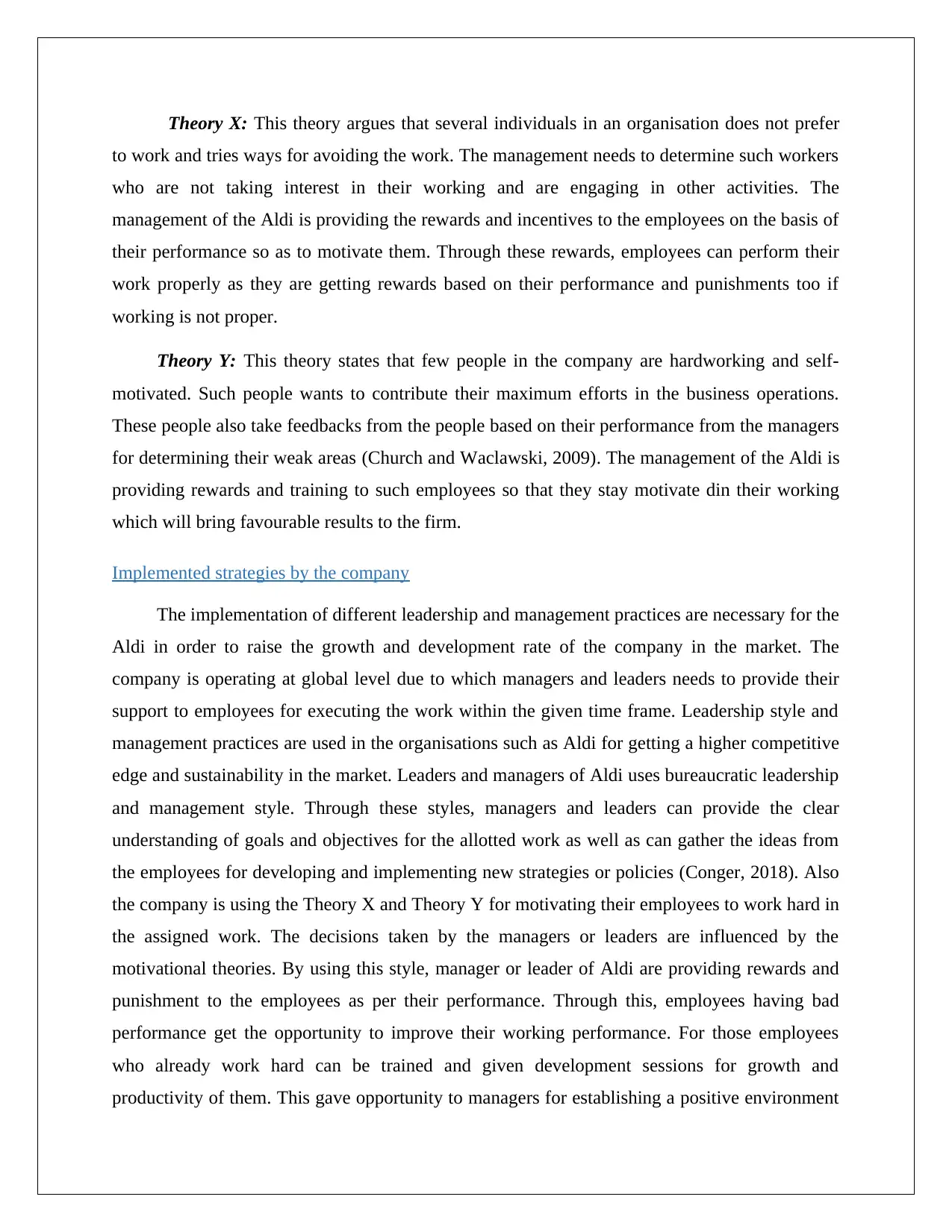
Theory X: This theory argues that several individuals in an organisation does not prefer
to work and tries ways for avoiding the work. The management needs to determine such workers
who are not taking interest in their working and are engaging in other activities. The
management of the Aldi is providing the rewards and incentives to the employees on the basis of
their performance so as to motivate them. Through these rewards, employees can perform their
work properly as they are getting rewards based on their performance and punishments too if
working is not proper.
Theory Y: This theory states that few people in the company are hardworking and self-
motivated. Such people wants to contribute their maximum efforts in the business operations.
These people also take feedbacks from the people based on their performance from the managers
for determining their weak areas (Church and Waclawski, 2009). The management of the Aldi is
providing rewards and training to such employees so that they stay motivate din their working
which will bring favourable results to the firm.
Implemented strategies by the company
The implementation of different leadership and management practices are necessary for the
Aldi in order to raise the growth and development rate of the company in the market. The
company is operating at global level due to which managers and leaders needs to provide their
support to employees for executing the work within the given time frame. Leadership style and
management practices are used in the organisations such as Aldi for getting a higher competitive
edge and sustainability in the market. Leaders and managers of Aldi uses bureaucratic leadership
and management style. Through these styles, managers and leaders can provide the clear
understanding of goals and objectives for the allotted work as well as can gather the ideas from
the employees for developing and implementing new strategies or policies (Conger, 2018). Also
the company is using the Theory X and Theory Y for motivating their employees to work hard in
the assigned work. The decisions taken by the managers or leaders are influenced by the
motivational theories. By using this style, manager or leader of Aldi are providing rewards and
punishment to the employees as per their performance. Through this, employees having bad
performance get the opportunity to improve their working performance. For those employees
who already work hard can be trained and given development sessions for growth and
productivity of them. This gave opportunity to managers for establishing a positive environment
to work and tries ways for avoiding the work. The management needs to determine such workers
who are not taking interest in their working and are engaging in other activities. The
management of the Aldi is providing the rewards and incentives to the employees on the basis of
their performance so as to motivate them. Through these rewards, employees can perform their
work properly as they are getting rewards based on their performance and punishments too if
working is not proper.
Theory Y: This theory states that few people in the company are hardworking and self-
motivated. Such people wants to contribute their maximum efforts in the business operations.
These people also take feedbacks from the people based on their performance from the managers
for determining their weak areas (Church and Waclawski, 2009). The management of the Aldi is
providing rewards and training to such employees so that they stay motivate din their working
which will bring favourable results to the firm.
Implemented strategies by the company
The implementation of different leadership and management practices are necessary for the
Aldi in order to raise the growth and development rate of the company in the market. The
company is operating at global level due to which managers and leaders needs to provide their
support to employees for executing the work within the given time frame. Leadership style and
management practices are used in the organisations such as Aldi for getting a higher competitive
edge and sustainability in the market. Leaders and managers of Aldi uses bureaucratic leadership
and management style. Through these styles, managers and leaders can provide the clear
understanding of goals and objectives for the allotted work as well as can gather the ideas from
the employees for developing and implementing new strategies or policies (Conger, 2018). Also
the company is using the Theory X and Theory Y for motivating their employees to work hard in
the assigned work. The decisions taken by the managers or leaders are influenced by the
motivational theories. By using this style, manager or leader of Aldi are providing rewards and
punishment to the employees as per their performance. Through this, employees having bad
performance get the opportunity to improve their working performance. For those employees
who already work hard can be trained and given development sessions for growth and
productivity of them. This gave opportunity to managers for establishing a positive environment
⊘ This is a preview!⊘
Do you want full access?
Subscribe today to unlock all pages.

Trusted by 1+ million students worldwide
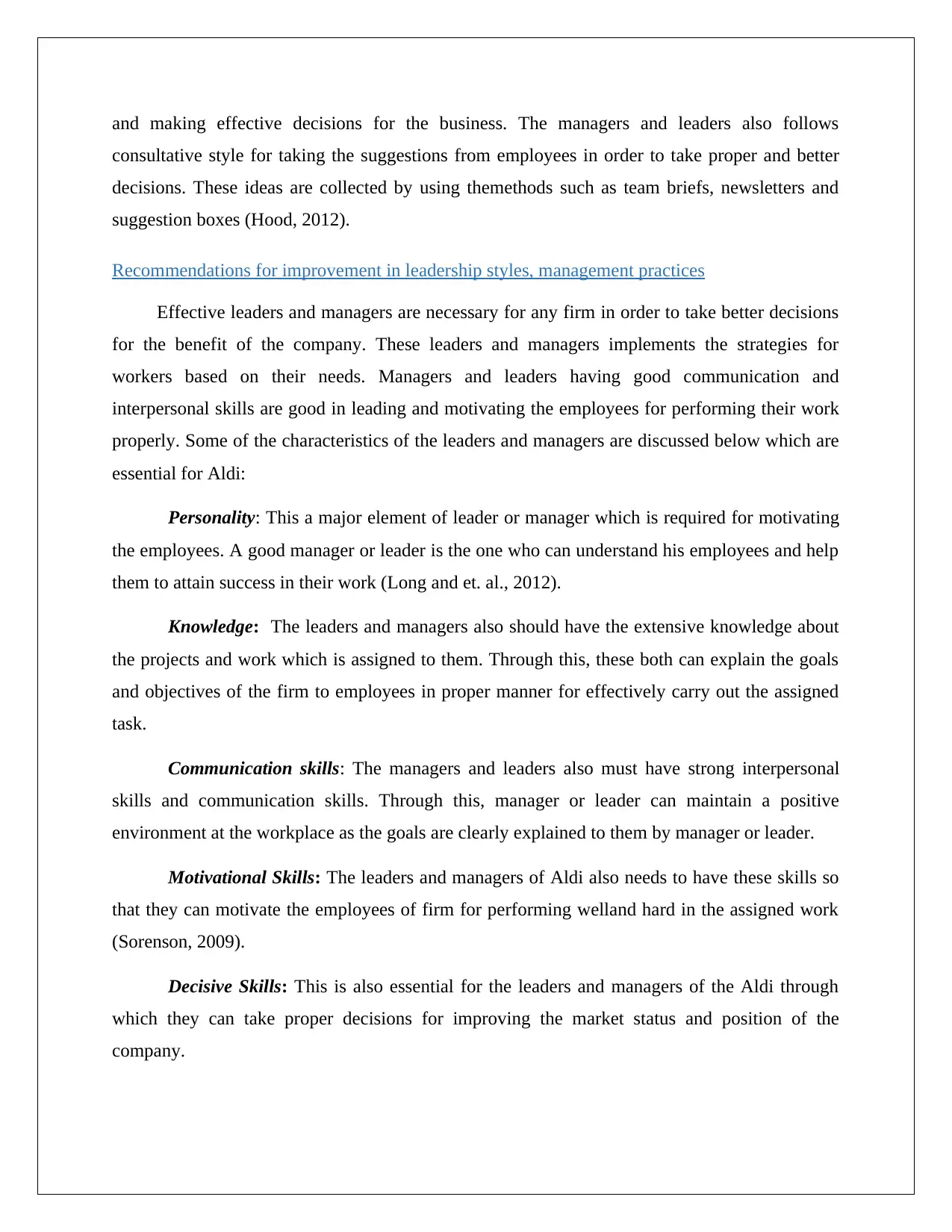
and making effective decisions for the business. The managers and leaders also follows
consultative style for taking the suggestions from employees in order to take proper and better
decisions. These ideas are collected by using themethods such as team briefs, newsletters and
suggestion boxes (Hood, 2012).
Recommendations for improvement in leadership styles, management practices
Effective leaders and managers are necessary for any firm in order to take better decisions
for the benefit of the company. These leaders and managers implements the strategies for
workers based on their needs. Managers and leaders having good communication and
interpersonal skills are good in leading and motivating the employees for performing their work
properly. Some of the characteristics of the leaders and managers are discussed below which are
essential for Aldi:
Personality: This a major element of leader or manager which is required for motivating
the employees. A good manager or leader is the one who can understand his employees and help
them to attain success in their work (Long and et. al., 2012).
Knowledge: The leaders and managers also should have the extensive knowledge about
the projects and work which is assigned to them. Through this, these both can explain the goals
and objectives of the firm to employees in proper manner for effectively carry out the assigned
task.
Communication skills: The managers and leaders also must have strong interpersonal
skills and communication skills. Through this, manager or leader can maintain a positive
environment at the workplace as the goals are clearly explained to them by manager or leader.
Motivational Skills: The leaders and managers of Aldi also needs to have these skills so
that they can motivate the employees of firm for performing welland hard in the assigned work
(Sorenson, 2009).
Decisive Skills: This is also essential for the leaders and managers of the Aldi through
which they can take proper decisions for improving the market status and position of the
company.
consultative style for taking the suggestions from employees in order to take proper and better
decisions. These ideas are collected by using themethods such as team briefs, newsletters and
suggestion boxes (Hood, 2012).
Recommendations for improvement in leadership styles, management practices
Effective leaders and managers are necessary for any firm in order to take better decisions
for the benefit of the company. These leaders and managers implements the strategies for
workers based on their needs. Managers and leaders having good communication and
interpersonal skills are good in leading and motivating the employees for performing their work
properly. Some of the characteristics of the leaders and managers are discussed below which are
essential for Aldi:
Personality: This a major element of leader or manager which is required for motivating
the employees. A good manager or leader is the one who can understand his employees and help
them to attain success in their work (Long and et. al., 2012).
Knowledge: The leaders and managers also should have the extensive knowledge about
the projects and work which is assigned to them. Through this, these both can explain the goals
and objectives of the firm to employees in proper manner for effectively carry out the assigned
task.
Communication skills: The managers and leaders also must have strong interpersonal
skills and communication skills. Through this, manager or leader can maintain a positive
environment at the workplace as the goals are clearly explained to them by manager or leader.
Motivational Skills: The leaders and managers of Aldi also needs to have these skills so
that they can motivate the employees of firm for performing welland hard in the assigned work
(Sorenson, 2009).
Decisive Skills: This is also essential for the leaders and managers of the Aldi through
which they can take proper decisions for improving the market status and position of the
company.
Paraphrase This Document
Need a fresh take? Get an instant paraphrase of this document with our AI Paraphraser
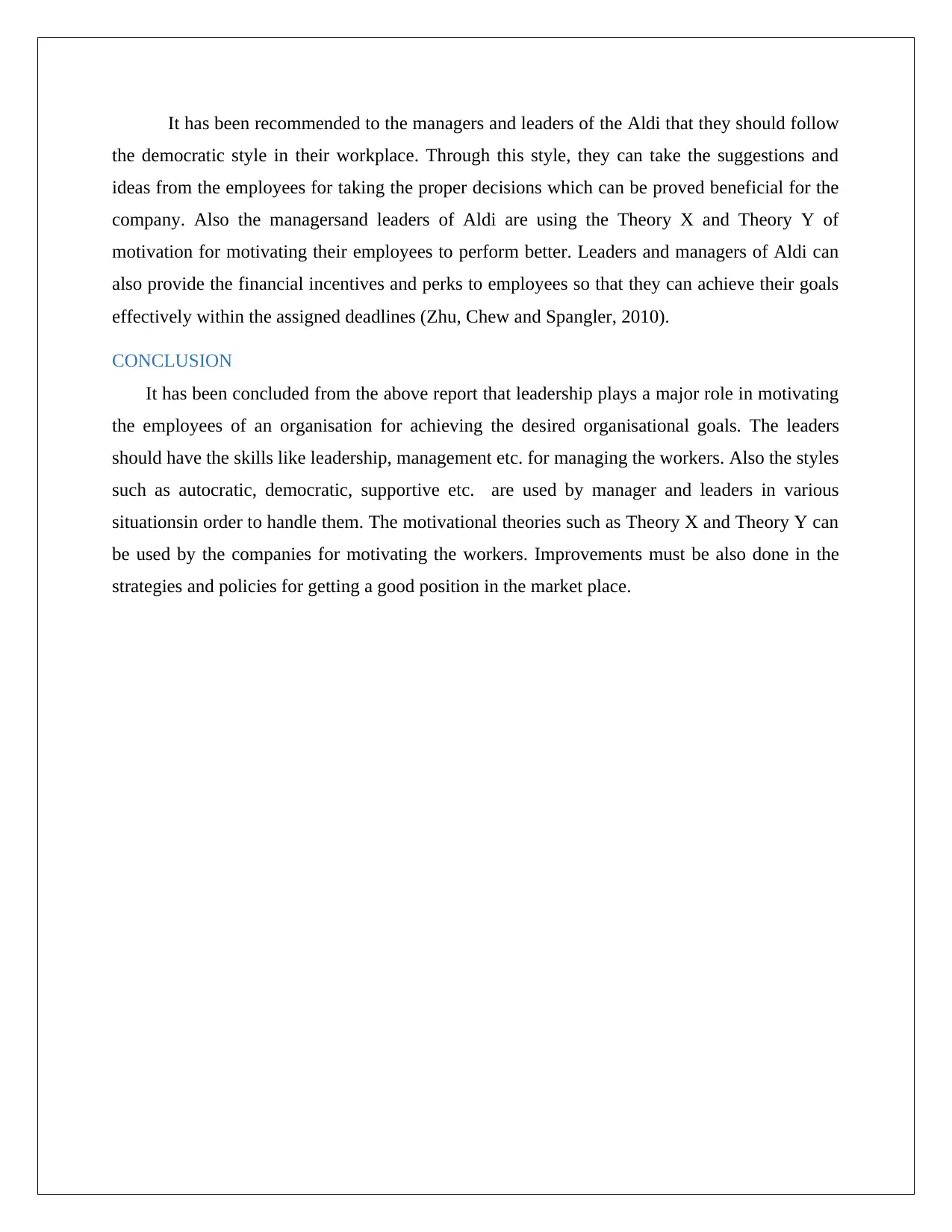
It has been recommended to the managers and leaders of the Aldi that they should follow
the democratic style in their workplace. Through this style, they can take the suggestions and
ideas from the employees for taking the proper decisions which can be proved beneficial for the
company. Also the managersand leaders of Aldi are using the Theory X and Theory Y of
motivation for motivating their employees to perform better. Leaders and managers of Aldi can
also provide the financial incentives and perks to employees so that they can achieve their goals
effectively within the assigned deadlines (Zhu, Chew and Spangler, 2010).
CONCLUSION
It has been concluded from the above report that leadership plays a major role in motivating
the employees of an organisation for achieving the desired organisational goals. The leaders
should have the skills like leadership, management etc. for managing the workers. Also the styles
such as autocratic, democratic, supportive etc. are used by manager and leaders in various
situationsin order to handle them. The motivational theories such as Theory X and Theory Y can
be used by the companies for motivating the workers. Improvements must be also done in the
strategies and policies for getting a good position in the market place.
the democratic style in their workplace. Through this style, they can take the suggestions and
ideas from the employees for taking the proper decisions which can be proved beneficial for the
company. Also the managersand leaders of Aldi are using the Theory X and Theory Y of
motivation for motivating their employees to perform better. Leaders and managers of Aldi can
also provide the financial incentives and perks to employees so that they can achieve their goals
effectively within the assigned deadlines (Zhu, Chew and Spangler, 2010).
CONCLUSION
It has been concluded from the above report that leadership plays a major role in motivating
the employees of an organisation for achieving the desired organisational goals. The leaders
should have the skills like leadership, management etc. for managing the workers. Also the styles
such as autocratic, democratic, supportive etc. are used by manager and leaders in various
situationsin order to handle them. The motivational theories such as Theory X and Theory Y can
be used by the companies for motivating the workers. Improvements must be also done in the
strategies and policies for getting a good position in the market place.
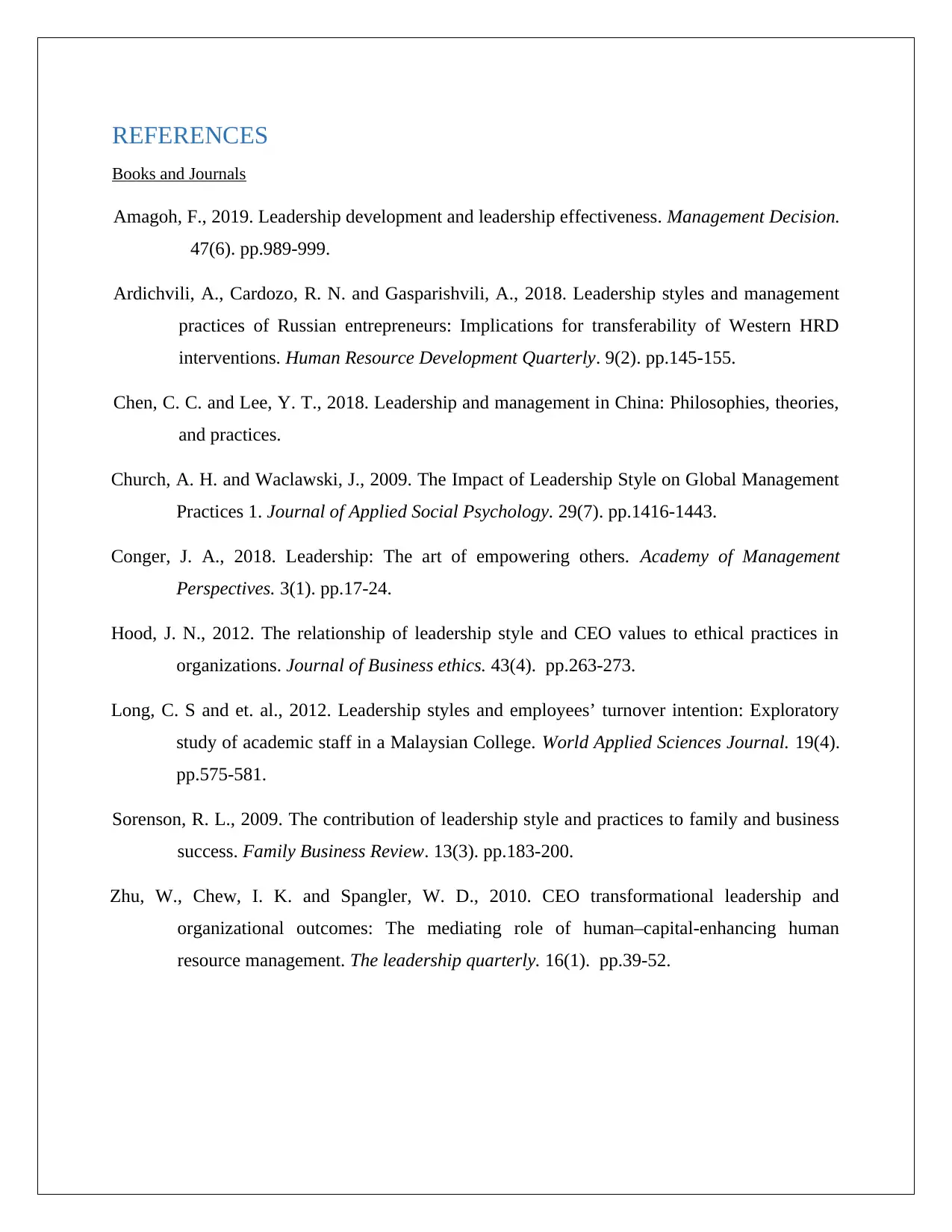
REFERENCES
Books and Journals
Amagoh, F., 2019. Leadership development and leadership effectiveness. Management Decision.
47(6). pp.989-999.
Ardichvili, A., Cardozo, R. N. and Gasparishvili, A., 2018. Leadership styles and management
practices of Russian entrepreneurs: Implications for transferability of Western HRD
interventions. Human Resource Development Quarterly. 9(2). pp.145-155.
Chen, C. C. and Lee, Y. T., 2018. Leadership and management in China: Philosophies, theories,
and practices.
Church, A. H. and Waclawski, J., 2009. The Impact of Leadership Style on Global Management
Practices 1. Journal of Applied Social Psychology. 29(7). pp.1416-1443.
Conger, J. A., 2018. Leadership: The art of empowering others. Academy of Management
Perspectives. 3(1). pp.17-24.
Hood, J. N., 2012. The relationship of leadership style and CEO values to ethical practices in
organizations. Journal of Business ethics. 43(4). pp.263-273.
Long, C. S and et. al., 2012. Leadership styles and employees’ turnover intention: Exploratory
study of academic staff in a Malaysian College. World Applied Sciences Journal. 19(4).
pp.575-581.
Sorenson, R. L., 2009. The contribution of leadership style and practices to family and business
success. Family Business Review. 13(3). pp.183-200.
Zhu, W., Chew, I. K. and Spangler, W. D., 2010. CEO transformational leadership and
organizational outcomes: The mediating role of human–capital-enhancing human
resource management. The leadership quarterly. 16(1). pp.39-52.
Books and Journals
Amagoh, F., 2019. Leadership development and leadership effectiveness. Management Decision.
47(6). pp.989-999.
Ardichvili, A., Cardozo, R. N. and Gasparishvili, A., 2018. Leadership styles and management
practices of Russian entrepreneurs: Implications for transferability of Western HRD
interventions. Human Resource Development Quarterly. 9(2). pp.145-155.
Chen, C. C. and Lee, Y. T., 2018. Leadership and management in China: Philosophies, theories,
and practices.
Church, A. H. and Waclawski, J., 2009. The Impact of Leadership Style on Global Management
Practices 1. Journal of Applied Social Psychology. 29(7). pp.1416-1443.
Conger, J. A., 2018. Leadership: The art of empowering others. Academy of Management
Perspectives. 3(1). pp.17-24.
Hood, J. N., 2012. The relationship of leadership style and CEO values to ethical practices in
organizations. Journal of Business ethics. 43(4). pp.263-273.
Long, C. S and et. al., 2012. Leadership styles and employees’ turnover intention: Exploratory
study of academic staff in a Malaysian College. World Applied Sciences Journal. 19(4).
pp.575-581.
Sorenson, R. L., 2009. The contribution of leadership style and practices to family and business
success. Family Business Review. 13(3). pp.183-200.
Zhu, W., Chew, I. K. and Spangler, W. D., 2010. CEO transformational leadership and
organizational outcomes: The mediating role of human–capital-enhancing human
resource management. The leadership quarterly. 16(1). pp.39-52.
⊘ This is a preview!⊘
Do you want full access?
Subscribe today to unlock all pages.

Trusted by 1+ million students worldwide
1 out of 9
Related Documents
Your All-in-One AI-Powered Toolkit for Academic Success.
+13062052269
info@desklib.com
Available 24*7 on WhatsApp / Email
![[object Object]](/_next/static/media/star-bottom.7253800d.svg)
Unlock your academic potential
Copyright © 2020–2025 A2Z Services. All Rights Reserved. Developed and managed by ZUCOL.


